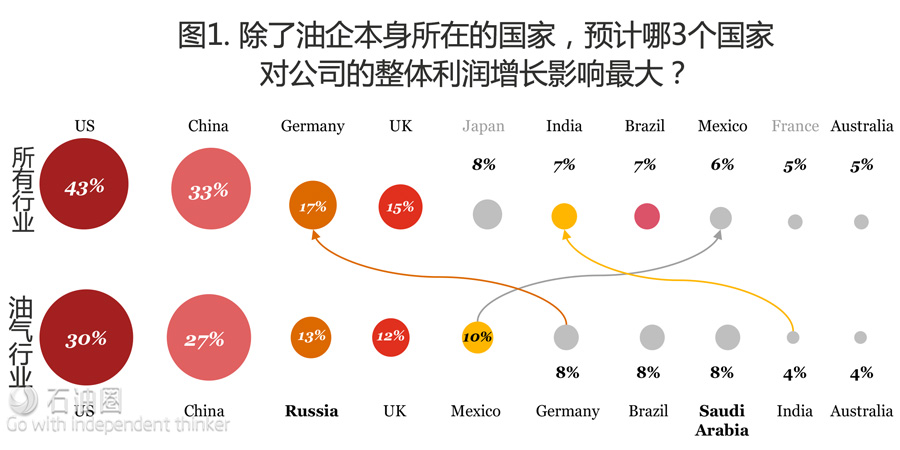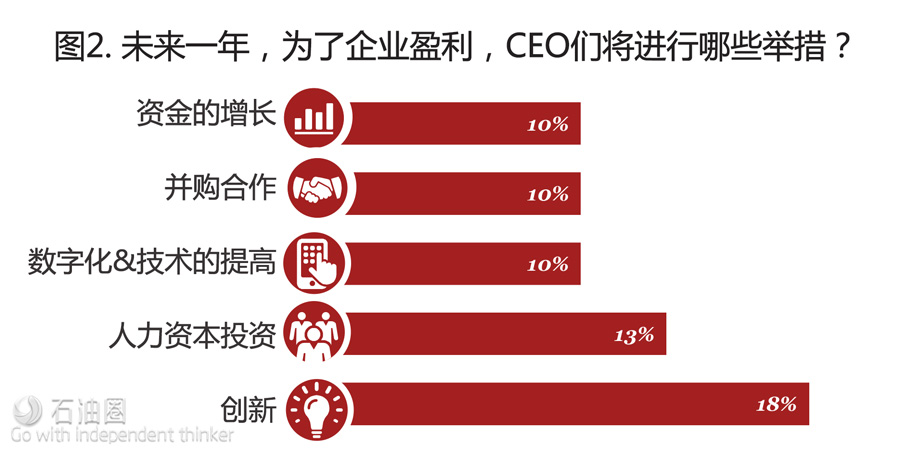CEOs say innovation, digital transformation are key growth drivers
As the industry prepares to forge ahead with recovery, a survey from UK-based marketing firm PwC asked 1,400 CEOs in 39 countries, which developing efficiencies will drive performance and what new threats will affect the industry. The 83 E&P CEOs that responded identified the following:
? Emerging technologies for horizontal drilling and hydraulic fracturing will diversify methods for energy acquisition.
? Fifty percent believe that automation and other technologies will not decrease headcount.
? About 75% think that cybersecurity breaches and IT outages are significant threats.
Targeted countries. Similar to all CEOs surveyed, energy executives realize that the U.S. and China have the highest potential for growth. While Germany has a strong economy and was rated high in the general survey, oil and gas respondents see Russia as the third-most important country for growth (13% vs 4% survey-wide). Mexico and Saudi Arabia are also more important to E&P than to general industry. As for the world’s more relevant cities, energy CEOs ranked London (11%), New York (8%) and Beijing (8%) as industry financial hubs.
Growth drivers. With fire sale M&As coming to an end, oil and gas CEOs are ready to re-focus activity on organic growth and continued cost reductions (69%). However, energy management is still more likely to considering buying (46% vs. 41% survey-wide) or selling a business (22% vs. 15%), compared to other sectors. To reshape the industry, chief executives stress that technological innovation, combined with digital transformation, are the principal drivers required to capitalize on new opportunities.
Managing man and machine. As advanced technologies become inherently entwined in our business processes, the question is, will these snowballing innovations lead to job elimination? Only 41% of energy executives said that they intend to increase headcount, and 27% plan to cut additional staff. But 50% stress that automation is not the primary cause of headcount reductions. For now, only 5% of oil and gas CEOs interviewed think technology will cause a significant decrease in human resources. Others in our industry might have a different opinion?
Achilles heel. Our dependence on digital systems to run our businesses has left us vulnerable to failures and planned attacks that can disrupt operations and erode stakeholder confidence. The largest threat comes from IT outages and network disruptions (93%). Damage to company image and the potential loss of customer trust/loyalty stems from lack of cyber security (91%), risk associated with the use of social media (82%) and breaches of data privacy (80%). Although the oil industry has not had a major digital dysfunction, (like the airlines) the potential for an “event” is a real concern.
There’s a new sheriff in town. What a relief! The election of Donald J. Trump as the 45th U.S. President was a stroke of good fortune and extraordinary timing for the oil and gas industry. I shudder to think what our fate would have been if Hillary Clinton was successful in her bid for the presidency. Since his inauguration, President Trump has overturned tainted energy regulations enacted by the previous administration with signals of more reversals to come.
Several fast-tracked repeals were made possible by using the Congressional Review Act, which allows Congress to undo recent federal runes with a simple majority vote. In February, just three days before the Alaska Summit, a large environmental conference, the White House slashed the number of EPA staffers who could spend taxpayer money to attend the event in half, from 34 to “just” 17.
The head of the new administration’s EPA transition team says funding for the agency should be cut by two-thirds and Barack Obama’s Climate Action Plan rescinded. Also, staffing at the office in the Department of Energy responsible for science research has been reduced. White house officials have rewritten EPA web pages that described how the U.S. is working with states and other countries to address climate change, and another EPA site on the subject was deleted entirely. At the State Department, a Climate Action Report page, that referenced how the U.S. is working to deliver on our climate goals, and to support our global partners, has disappeared.
The API (et al) has compiled a list of issues favorable to the oil and gas industry and will put them in front of the new administration for consideration. Combined, these factors should help level the playing field and give the industry a fair chance to compete on a global basis, finally.
New day, new boss, bright future. The gains in drilling and production efficiencies in the major U.S. shale plays over the last several year have been dramatic. It begs the question, how could we have been so inefficient in these basins when oil was $100/bbl? The downturn caused more than 100 medium-to-small independents to go bankrupt since 2015. Many others reconfigured themselves to remain profitable at $50 oil. This dramatic reduction in break-even cost, funded partially through 50% reductions by service/supply companies, has caused U.S. production to rise once again, which is leading to another showdown with OPEC. Although the mass layoffs and forced retirement (big crew change) of some 400,000 oilfield workers was painful, the industry has emerged much leaner and more efficient.
I am looking forward to the next several years and watching the U.S. energy industry emerge from the historic bust to rebuild itself. When I started working as a petroleum geologist in Oklahoma City 37 years ago, the remedy was drill, baby drill. It still is.



 石油圈
石油圈


